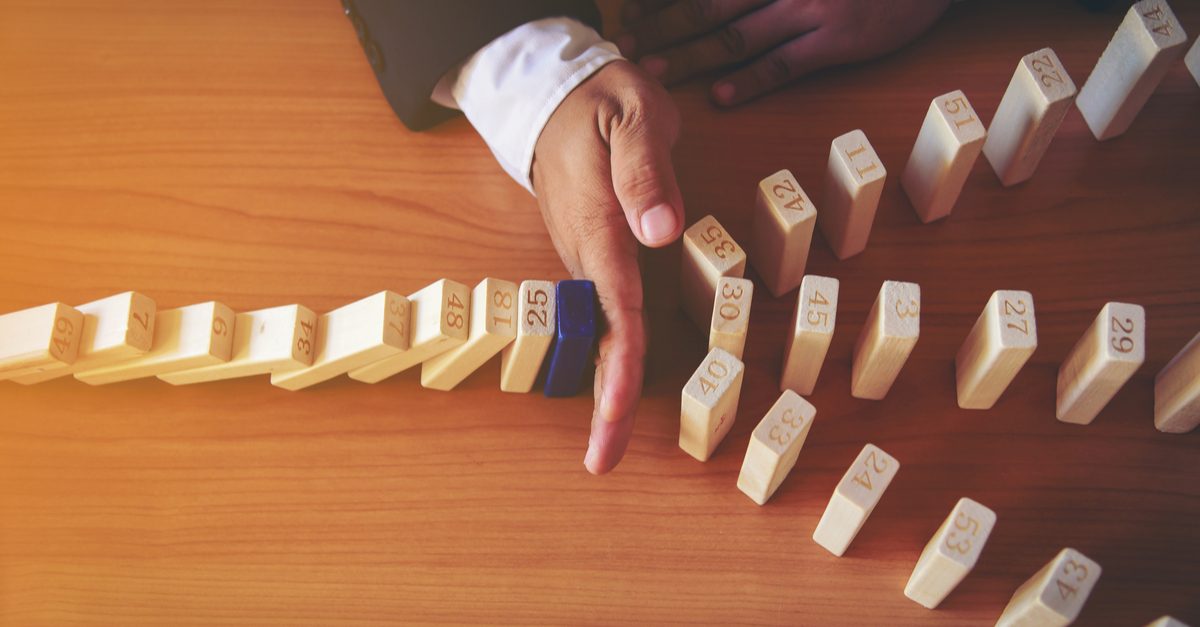11 Rules of Risk Management. Ultimate Guide

10 minutes for reading
As it has been mentioned lots of times, working on financial markets implies high risk; in order to become a successful trader, one should minimize potential risks. This article is devoted exactly to reducing them. I would like to mention that this list of actions was suggested by one of the Stocks&Commodities authors George R. Arrington.
Let us have a look at the list of rules necessary for minimizing possible losses. I think that if you trade or have ever traded before, you have used at least some of them, perhaps unconsciously.
1. Before opening a trade make a thorough analysis

Before putting your capital in danger, you should make sure that you have full information and realize well why you want to open the trade. Aside from a detailed analysis of charts, you should form a clear idea of the amount of capital you are ready to risk in this particular trade and of the point, where you are planning to enter the position, for the trade not to become losing even if the market turns against you.
Carrying out the analysis, prepare a list of instruments with a description of reasons for opening the trades and the levels of entrance and exit (if the number of your open positions is scarce, you can keep this list in mind). Upon calculating the risks, cross out too risky ones and those with ambiguous signals. This is the way to make a preliminary selection of trades and eliminate the least efficient of them.
2. Make a trading plan

What is more: if you put effort into creating the plan, stick to it. Each and every one speaks a lot about trading plans, though the views on their efficiency differ radically. Anyway, a plan is necessary as it helps avoid spontaneous actions, performed emotionally and leading to unreasonable losses. Having a well-drafted plan and following it, you will be insured from impulsive actions and will gain confidence.
What is the plan comprised of? It is basically a list of your everyday operations in accordance with your trading style. You have to make an investigation and create a method fitting you in all details, then write it down.
What is more, you should describe acceptable risk for every position and for all trades together, as well as your approximate goals, justifying the losses. If you embed a 2% risk into a trade and receive 1% on exit, you compromise your position at once, because sooner or later your losses will eat up your profit, and the trade will become losing. If during trading you deplete your loss limits, it would be wise to make a pause, exit the market and think about what has happened.
One more important hing: if at a certain moment you realize that the meaning of market events escapes you, do not follow the plan blindly, close all positions and wait for the situation to stabilize and become clearer. Also, do not open trades on the basis of someone’s view or advice, act independently after a thorough analysis of the situation.
3. Diversify your assets

Let us recall one more method, well-known bur not always used – diversification. It allows to decrease risks significantly, acting in two directions:
- regulating risks by the volume of opening trades;
- spreading risks between various instruments.
As for the volume of positions, one thing that you definitely should not do is placing all funds in one trade. Define the risk level for each position and limit it by a Stop Loss. Speaking about instruments, try to create a range of assets with the least correlation between each other, so that their price fluctuations and trend directions seldom matched. This way you will diversify risks and avoid dependence on parallel impulses in correlating groups, which bring losses in all trades if the market goes negative.
4. Do not put all your savings on your trading account

It is recommended to use only part of your capital for trading. As the saying goes, do not put all your eggs in one basket. What is more, if a trade looks especially appealing, still do not be tempted to open it for the whole deposit, as the market may turn against you any moment. Make sure you have enough money on your account to keep the trades open easily. It is best to have some reserve on a separate account in order to restore the margin quickly in case of an undesirable price movement. Some traders purposefully open several accounts for trading or deposit the main account for such a sum that will let them open just one or two trades to avoid the temptation of putting all money in trading.
5. Use a Stop Loss

It has been spoken about so many times that has become tiresome. However, practice shows that this measure is still relevant. This is a trustworthy way of closing your losing positions timely and saving your deposit from unplanned losses and unnecessary risks.
Even if you think that you are able to control your positions on the market yourself and close them manually – you are not. It is enough to get distracted for 5-10 minutes, and a steep price movement lessens your deposit significantly; or the connection fails at the most critical moment, or a trouble with power supply emerges. After all, at a crucial moment you may not be decisive enough to close a losing trade (it is always sad to lose money), and you will be watching your deposit melt, hoping for a price reversal.
What is more, you can use a Stop Loss that depends on the time. If the order remains on the market for a certain period of time without serious price changes, the trade closes regardless of the results.
6. Prefer trading along the trend

Following the trend minimizes the possibility of losses, in contrast with counter-trend trading or the reversal-catching strategy. If you are trading along the trend, even a not quite exact entrance to the position still allows for closing the trade if not with profit, then at least without losses. In case the moment is particularly bad for opening a trade, decrease your risk.
7. Do not be afraid of recognizing that you were wrong and getting a loss

It is usually quite hard to recognize your own mistakes. But if you learn to do so and close losing trades in time, you will save the biggest part of your deposit. Just remember, that pro traders suffer losses same as you do. They rely on a well-known rule: cut on your losses and let your profit grow.
It is also worth remembering that simultaneously with the price moving against the trend you should decrease the risk and by no means fill up the already losing position, hoping for a pullback. Why is the latter forbidden? You increase your risks, so the speed of receiving losses may also grow significantly (depending on the size of fill-ups) – if you fill up with the same lot that you had in the trade initially, you double the risk; a fill-up with a doubled lot triples the risk.
However, if you do understand what is going on on the market and you have a concrete plan, you can get into another trap. For example, you have sold 1 lot EURUSD, and the price started growing. You realize that upon reaching the nearest strong level the price will bounce off and let you exit the trade without losses. On the expected level you fill up, and if everything goes according to the plan with a bounce strong enough, you may think that it would be wrong to exit without profit after waiting for so long, so you make a decision to wait more for profit. And here is the trap: if yo do not grasp at the opportunity to exit the trade without losses, your final loss may double due to the fill-up.
There are plenty of variants of such circumstances; this example is meant for you to understand the possible consequences of averaging. Try not to open next position right after suffering a loss: you will be pushed to it by the desire to get back your money, but a trade driven by emotions is seldom weighted up and analyzed thoroughly.
8. Remember about protective measures

Before opening a trade, calculate how much you can afford to lose and compare the result with your potential profit. Pay attention not to the size of the loss or profit but to their ratio. You should be fully comfortable with the size of the loss; always remember that the price may go against your trade any moment. Every trade requires a plan of following and closing it: this is the only way of guaranteed protection for your capital.
9. Trade moderately

The number of trades do not guarantee their success. You can make one very profitable trade, or you can make 10 minor losing ones, so that the aggregate losses will eat up the profit gained before. A trader should be picky: it is better to miss 5 ambiguous signals and wait for one really strong and trustworthy to enter the market. Have patience and do not let the desire to always remain on the market dominate you. Select your trades carefully and remember that the less trades you have, the less your expenses are, such as splits, slips, negative swaps and commission fees.
10. Take your emotions under control

Emotions are an essential part of the life of each person; everyday trading, work with finance, especially losses, deteriorate your emotional state, leading to stress and nervous collapses. A trader may worry about an open trade, be desperate in case of large losses and feel other negative emotions that have adverse effects on analyzing the perspectives of trades. That is why for a trader it is especially important to be able to calm down quickly and prevent emotions from dominating reason.
The risk allowed for your trades influence your emotional state directly. The less the risk, the calmer your trading goes.
Learn to concentrate on your standard everyday routine: market analysis, evaluation of trades, calculation of the entrance and exit levels. Make your decisions on the basis of this data, not your fantasy.
11. If you have doubts, exit the market

If you have any doubts about the already open positions or those you are going to open, it will be best to close all orders and stop trading. Doubts are sort of an indicator or a hint, signaling that you have, perhaps, missed something or miscalculated. Do not risk your money if you have lost confidence for some reason.
Exit the market in the following cases:
- you do not fully understand the market situation;
- you are not sure about the perspectives of your open positions;
- you are feeling lost;
- you are suffering insomnia due to your open orders on the market.
To sum it up, let us single out 4 main pieces of advice for working with risks:
- fully understand the risk of the position;
- eliminate all unnecessary risks;
- select signals carefully and avoid inefficient trades;
- close losing trades immediately to prevent risks from growing.







